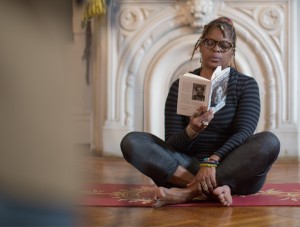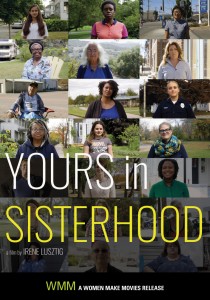
Still from The Cancer Journals Revisited
The Cancer Journals Revisited is a film that honors the life of Black, lesbian, mother, warrior, poet Audre Lorde. In this film, Lana Lin reflects on the meanings and implications of Lorde’s memoir The Cancer Journals (1980) by joining the text with interviews of 27 current and former breast cancer patients. The patients featured in the film are largely women of color. They read aloud and reflect on excerpts from Lorde’s memoir, sharing personal anecdotes and messages about what it is like to navigate illness and treatment in America. While not restricted to a solely American context, the film’s focus on American society is reflective of the critiques found in Lorde’s memoir. As the audience learns about the experiences of the various readers, viewers are also presented with information about Lorde’s life in the form of on-screen text and shots of archived materials––such as The Cancer Journals’ original manuscript box. Lin also inserts herself into the film through text overlay, acting as a “container” or “holding environment” to support the readers’ stories.
In a class conversation with the director, Lin described The Cancer Journals Revisited as a film, shying away from the labels documentary and experimental. This perspective is absent from reviews of the film, as most film festivals have placed The Cancer Journals Revisited in the documentary category. During this conversation, Lin also spoke about her decision to produce a film combining 4K, 16mm, and super 8mm raw stock shots. She explained that the decision to film on leftover raw stock came before she conducted the readings and interviews. Throughout the film, the raw stock serves as B-roll. In some scenes, Lin’s interviews begin with the interviewee on-screen and shift to a voice-over. For example, one reader’s interview served as a voice-over for an extended shot of two people doing Acro Yoga. While some of the scenes could be considered distracting, they display different bodies in relationship with one another––a major theme in Lorde’s life and writing. The Cancer Journals Revisited pays homage to Lorde in that it leaves out the opinion of cancer experts and centers the lived experiences of breast cancer patients of color.
Members of the TriCo can find The Cancer Journals memoir at this link: https://tripod.swarthmore.edu/permalink/01TRI_INST/j0hcq8/alma991005504359704921
Other prominent works by Audre Lorde include Zami: A New Spelling of my Name (1982) and Sister Outsider: Essays and Speeches (1984).
Source:
July, Beandrea. “Documentaries That Make New Connections Between the Personal and Political.” Hyperallergic, 2019. (https://hyperallergic.com/512472/blackstar-film-festival-documentaries/).



